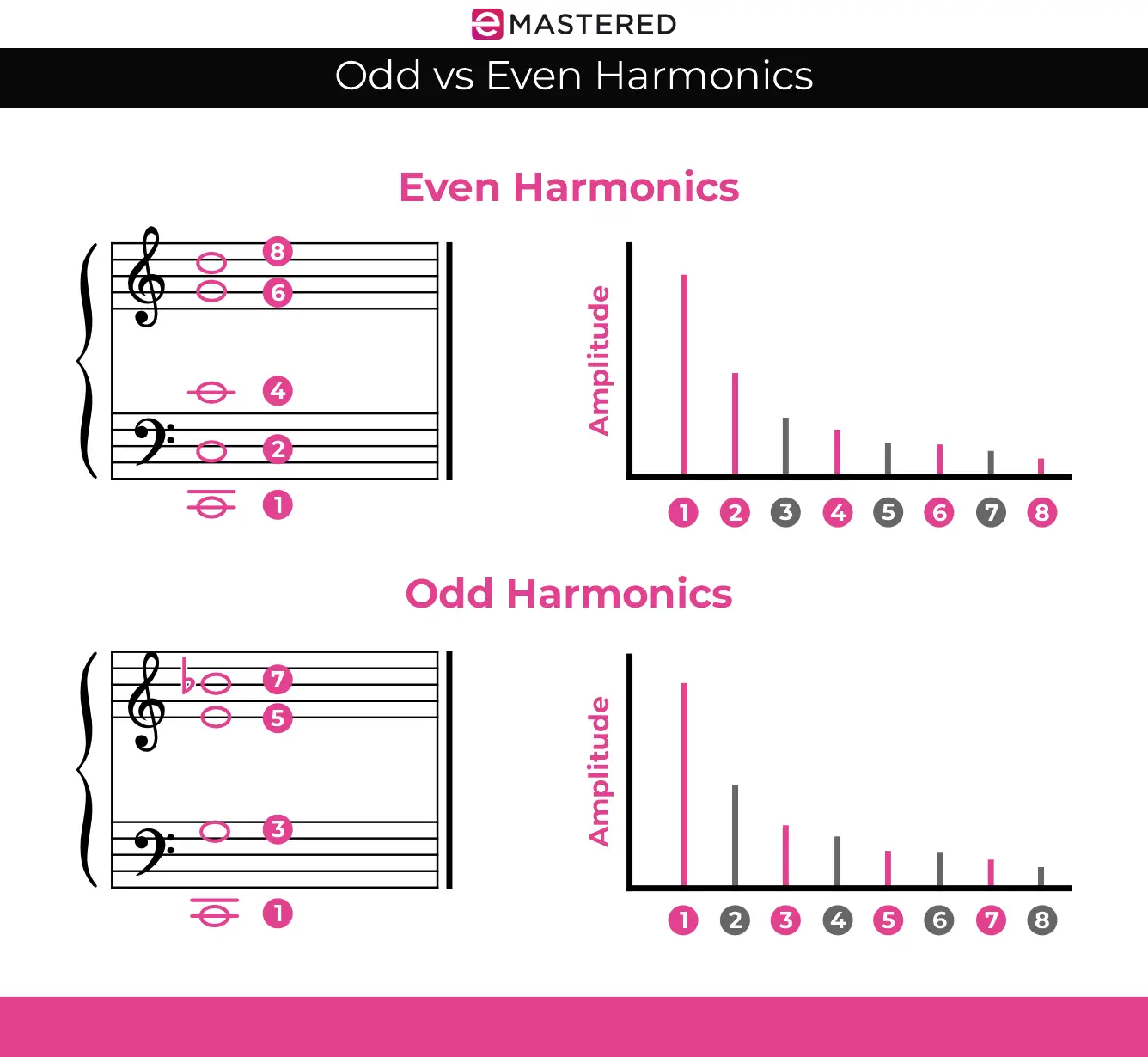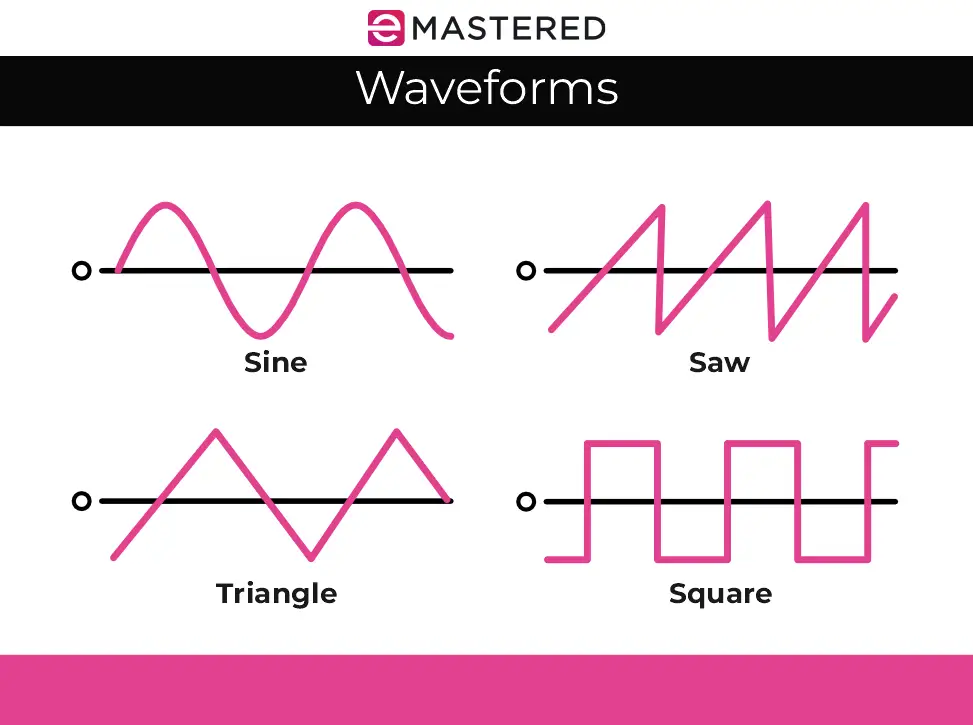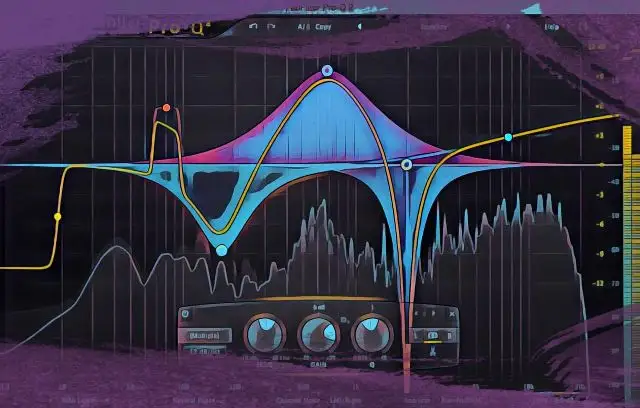We rarely spend time thinking about harmonics when we're producing, though similar to how we only exist because our cells exist, music as we know and love only exists because of harmonics. Understanding harmonics can be extremely beneficial as a musician, producer, mixing, or mastering engineer. So today, we're going to explore the ins and outs of these micro sound elements and how you can use this knowledge to be a better music creator.
The Basics of Harmonic Frequencies
Harmonics are sound waves with frequencies that are integer multiples of the fundamental frequency of a signal . You can also think of them as the frequency ratio of such a signal.
To understand how this works, let's look at a basic sine wave.

The sine wave is the most fundamental sound wave we have, as it only has sound energy at a single frequency . For example, if we were playing a sine wave at C3 and you were looking at the note through a frequency spectrum analyzer, you'd only see movement concentrated at C3.
However, if we were to take the same fundamental frequency of C3 and use a square wave instead, we'd see frequency content above the fundamental frequency as well. The frequencies above, which would get softer and softer the higher they went, would be called harmonic frequencies .

These are the things that make a square wave sound like a square wave. Even beyond square waves, every sound known to man (except for sine waves, of course) has harmonic frequencies to some degree, though some are much more complex than others.
The important thing here is knowing how these harmonic frequencies are arranged in relation to the fundamental frequency.
Harmonic Frequency Arrangement
Let's say that we have a basic square wave at A4, which is 440 Hz.
The second harmonic in the harmonic series above it would be an octave above at A5 or 880 Hz . The third harmonic would be three times that fundamental frequency, which would be E6 or 1320 Hz , and the fourth harmonic would be four times the fundamental frequency at A6 or 1760 Hz .
This would go on and on and on until the frequencies were no longer hearable to us.
Every sound in every instrument produces these harmonics, and you'll often hear musicians refer to them as overtones , which is an interchangeable term for harmonic frequencies.
So, for example, let's say we had an acoustic guitarist who plucked the low E string . Not only would we hear that vibrating string at its lowest frequency or fundamental pitch, but we'd also hear the fractions of harmonic overtones above it, getting softer and softer the higher they went.
Odd vs. Even Harmonics

In the harmonic series, we have harmonics that are classified as either odd or even.
Odd harmonics are odd multiples of the fundamental frequency (3, 5, 7, 9, etc.). These tend to sound brighter and more excited than warmer, smoother even harmonics, which are even multiples of the fundamental frequency (2,4, 6, 8, etc.).
As we'll soon see, different instruments have distinct harmonic profiles, which give them their unique sonic characteristics.
Natural vs. Artificial Harmonics
The integer multiples of the fundamental that we just talked about above exist in nature. In fact, it's a natural mathematical equation that reads f(n) = n x f, where 'f' is the fundamental frequency and 'n' is the harmonic frequencies.
We talked about how these work when a guitar string is plucked, but what about other natural instruments?
The same thing goes for keyboards too. When a pianist, for example, plays a fundamental frequency, the strings and resonance of the instrument will output sympathetic vibrations, which create harmonics. A trumpet player, on the other hand, would use their embouchure to control the harmonic series above the fundamental frequency.
The way in which these harmonic frequencies are arranged can have a major impact on the overall timbre of an instrument. They're one of the reasons why a trumpet sounds so much different than a tuba, or why a low male human voice sounds so much different than a high female voice.
However, we can also generate harmonics electronically or artificially by manipulating waveforms.

On most synthesizers, you'll find waveform generators, giving you the option to adjust the number and type of harmonics above a sine wave. Here are a few of the main waveforms you'll find on just about any given synth:
- Sine Wave - As we said before, sine waves produce the cleanest and clearest sound, as they don't have any harmonics above them. People most often associate the sine wave with the pure tone. This sound does not exist in nature.
- Square Wave - Square waves, which are known for their bright, harmonically-rich timbres, are made up of a fundamental frequency and odd harmonics. These waves are very popular in electronic music. The arpeggiating synths at the beginning of the Stranger Things intro theme is a great example of square waves in action.
- Sawtooth Wave - Sawtooth waves offer even more harmonic richness than their square wave counterparts, using odd and even harmonics. They have a bright and buzzy timbre, which makes them excellent for leads. The lead in "Strobe" by Deadmau5 is a great example of a sawtooth wave in EDM.
- Triangle Wave - Triangle waves are a bit mellower than square and sawtooth waves, and though they only use odd harmonics, they sound different because of their unique amplitude distribution. I'm a big fan of triangle waves in chillwave music, as they have a soft, nostalgic sound to them. Check out the synths in "Feel It All Around" by Washed Out.
Why We Use Harmonics In Music Production, Mixing, and Mastering
Without harmonics, our music would lack tonal complexity. For that reason, producers and engineers will often use harmonics to add depth to their music. Not only do they allow us to distinguish instruments from one another in mixes, but they can also work to give us a more expressive aural energy and a three-dimensional listening experience.
Without light, there is no dark.
We can use that same idea in music to create contrast. For example, one might use an instrument with brighter and more excited harmonics to create contrast from an instrument with warmer and darker harmonics. The question, however, is how do we put our knowledge of harmonics into action?
Using the Harmonic Series to Make Your Music More Interesting
If you've spent a decent amount of time reading about mixing and music production online, you've likely heard about saturation.
Saturation is essentially controlled harmonic distortion. Producers and engineers will often use tools like tape machines, tube amps, or distortion plugins to add more harmonic character to their tracks.
For example, let's say I had a clean DI bass guitar, though it sounded a bit lifeless and boring in the context of a rock track. I might opt to run it through a distortion plugin to help it stand out in the mix amidst a wall of hard-hitting drums and distorted guitars.
In most instances, I'll do this in parallel by making a copy of the bass guitar, high-passing the copy to around 150-200 Hz to keep the low-end clean, distorting that copy with a saturation plugin, and blending it in with the original bass sound.
The same thing could go for an 808. If it sounded a bit lackluster in a mix, I'd use a saturation plugin to add complexity to the higher harmonics, helping the overall 808 to stand out.
This is a different process than EQ, which only allows you to cut and boost harmonics that are already there instead of creating new harmonics altogether. Let's take a look at some of the most popular tools we use to manipulate harmonics in our mixes.
Popular Tools for Manipulating Harmonics
EQ
EQ is one of the most fundamental mixing tools you have in your arsenal, as it allows you to manipulate the frequency balance of an audio signal or group of audio signals. With EQ, you can make a vocal, for example, sound darker, brighter, warmer, or more present, all by boosting or attenuating specific bands on the frequency spectrum to change the amplitude of the present harmonics.
In pop music, you might choose to boost the higher harmonics on a vocal with a high shelf and attenuate the lower harmonics with a low cut.
As I previously mentioned, harmonics are what give the music we make depth. However, when too many harmonics in the same portion of the frequency spectrum are overlapping from different instruments in a mix, we lose clarity. EQ is one of the best tools for balancing frequency relationships between multiple signals to make our mixes more clear.
Compression
We don't often think of compressors as harmonic tools, as they exist primarily to control dynamic range. However, compression can have a huge impact on the fundamental frequency of a signal and its harmonics.
For example, if you use compression on a sustained bass guitar signal, you effectively bring out the quieter harmonics on softer passages where they would otherwise be in a state of decay.
Saturation
Saturation is by far the most common way engineers manipulate harmonic content in mixes, as saturation can be used to add harmonics to a signal.
For example, you could use a tape saturation plugin to add color and warmth to an audio signal and give it the harmonically rich overtones often associated with the 'sound of analog.' On the other hand, you could run a guitar through a fuzz pedal, which would introduce a smattering of odd and even harmonics paired with a waveform clipper to give it a brighter, more cutting sound.
5 Ways to Use Harmonics In Your Mixes
Let's take what we now know about harmonics and look at some ways in which you can utilize their power in your mixes.
1. Adding Analog Warmth to Digital Mixes
This first example is a pretty general one, though it can be extremely helpful when we're dealing with sterile-sounding mixes that need a bit more character.
Whenever I think of the words 'warmth' and 'harmonic distortion,' I think of tape or tube saturation .
I highly recommend getting your hands on some decent tape or tube saturation plugins to add subtle harmonic distortion to your mixes and give them a more analog sound. Tape saturation is a bit subtler than tube saturation, perfect for adding a sense of warmth to individual tracks, such as vocals or synths, or glue to groups of tracks, such as drums or full mixes.
Tube saturation is typically used if you want a more hard-clipped saturation sound, perfect for guitars or vocals, as it can add more 'thickness' to the mid-range.
My favorite tape saturation plugins:
- Waves J37
- Slate Virtual Tape Machine
- UAD Ampex ATR-102
My favorite tube saturation plugins:
- PSP VintageWarmer 2
- UAD Thermionic Culture Vulture
- Softube Tube-Tech CL 1B
2. Make Vocals More Present
With the right style of saturation, you can help vocals stand out in mixes.
While you could certainly run a vocal through a basic distortion plugin, such as the SansAmp PSA-1 on Pro Tools, and call it a day, most of the time, you'll want to get the sound of harmonic distortion without it being distorted. This is where blending the sound of the distorted vocal in parallel with the clean vocal can be helpful.
One of my favorite plugins for doing this is the Soundtoys Decapitator . I'll often use it to dial-in relatively heavy distortion on my vocal track using the large Drive knob, use the tone knob, filters, and saturation styles along the bottom to adjust the overall timbre of the saturation, then dial it back using the mix knob until I have the perfect balance of clarity and saturation in my vocal track.
On the other hand, if a super bright vocal is what you're after, use a saturation plugin that focuses on higher harmonics instead of boosting a high shelf on an EQ.
One of my favorite plugins for this is the Aphex Vintage Exciter from Waves.
PRO TIP: I recommend inserting a de-esser before using a saturation plugin like this so that the saturation plugin can give you a balanced, present tone without accentuating sibilance.
3. Managing Transient Material
Once in a while, I find myself working with audio signals that have too much transient detail. While drums are often the main culprits, it could be anything from an acoustic guitar that sounds too plucky to a piano with too much attack on the front end.
While you can usually dull transient material with compression or transient shaping, saturation can offer a wonderful balance between transient preservation and softening that can be very pleasing in a mix.
Let's say you have a snare drum that sounds way too punchy in your mix. You can apply a subtle amount of saturation to your signal (tape saturation is often my go-to in this case), increasing the level of the snare going into the plugin to soften the transient material.
The reason this works is that saturation introduces a unique type of compression. It often involves a form of soft clipping, where the audio signal going into the saturator is gently limited, clipping off the peaks of the signal's wave form and providing compression-like characteristics.
4. Remove Harshness
Saturation is one of the best tools to remove harshness from a signal without compromising its overall presence.
For example, let's say you recorded drums in a poorly treated room or with cheap overhead mics. In either case, you might end up with cymbals that sound really harsh. Even the smallest amount of saturation can help remove the harshness in your cymbals by rolling off the top end while retaining its crispy clarity.
The same thing can go for vocals, snares, electric guitars, or any other element in your mix that doesn't sound pleasing to the ear.
5. Glue a Mix Together
Lastly, you can use harmonics to glue your entire mix together and make it sound more cohesive. Often, this is a very subtle approach, as you don't want to add distortion or take the punch out of your mix by dulling the transients too hard.
I'll often use tape saturation on the mix bus, dialing it in slightly to round off overall mix harshness and give my mix a sense of natural, musical coloration. A little bit can go a long way here. I recommend applying tape saturation to your mix buss and listening to how your track reacts at the loudest point of the song to make sure you're not introducing distortion.
Taking Advantage of the Natural World
Harmonics have existed in nature long before we engineered instruments and technology to control and manipulate them. They're one of the reasons music resonates so viscerally with human beings.
Of course, though they're universal, the ways in which we use harmonics in music have changed quite drastically over time and across different cultures, and that's one of the reasons we have such incredible musical diversity.
I hope this article has demystified harmonics at least a little bit for you, as finding ways to use them in your music can be wildly rewarding, especially when you consider the fact that you're using a tool that has existed since the beginning of time.





